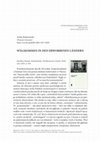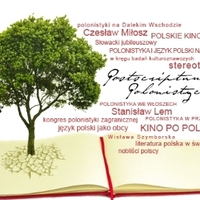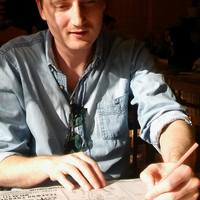Papers by Artur Kamczycki
Studia Europaea Gnesnensia, 2021
Willkommen in den erworbenen Ländern, rec. książki: Karolina Kuszyk, Poniemieckie
Journal of Modern Jewish Studies, 2021

Journal of Modern Jewish Studies
ABSTRACT At the end of the nineteenth century Theodore Herzl presented ideas that would embrace t... more ABSTRACT At the end of the nineteenth century Theodore Herzl presented ideas that would embrace the visual arts in order to promote the new Zionist movement. Art was to play an important role in forming Zionist awareness, with Herzl's image expressing the ideas, as well as personifying Zionism and the Jews. However, a part of the Jewish religious community could not come to terms with the fact that Western European art had found its way into Jewish culture, therefore all debates on all visual aspects of Zionism were based on aniconism. This is why, some images of Herzl try to avoid direct visualization of the face, the most notable examples being profile pictures, silhouette images, micrographics, presenting him from behind or in dim light. All these modes of incomplete representation found their justification in traditional Jewish texts relating to the visual arts.
Studia Europaea Gnesnensia, 2020

Prawdziwa historia: lata 90. XX wieku. Grupa licealistów z Zielonej Góry stoi przed zamkiem króle... more Prawdziwa historia: lata 90. XX wieku. Grupa licealistów z Zielonej Góry stoi przed zamkiem królewskim w Warszawie. Nauczycielka mówi: "moi drodzy, znajdujemy się teraz przed bardzo ważnym, zabytkowym budynkiem". Nagle jeden z uczniów przerywa: "O! to musi być poniemieckie". Sytuacja ta jest z natury swej dość "szkolna", a nawet naiwna, ale obrazuje pewien społeczno-psychologiczny fenomen dotyczący wielu Polaków wychowanych w miastach i miasteczkach przyłączonych do kraju po drugiej wojnie światowej. Jak się okazuje, nawet w końcu XX wieku dla części "zachodnich kresowiaków" każda godna uwagi architektura zawiera w sobie niezmazywalną "jakość" odziedziczoną po jej pierwotnych właścicielach. Nie chodzi tu więc tylko o estetyczny zachwyt, ale o ukrytą w tym nutę obcości; o coś, co jest nie do końca własne, "oswojone" i udomowione. To "poniemieckie"-jak jakieś uporczywe echo-tkwi nie tylko w solidnych murach, ścianach, fasadach i portalach, ale też głęboko w parkach i lasach, na polach, wzdłuż rzek i torów kolejowych; w kamiennych brukach i lipowych alejach łączących wsie i miasteczka. To "coś" tkwi w domowych serwisach, pod talerzem na zupę, w "zucker-niczkach", "zentrefugach" i w starym zegarku na ręce. Czasem w wekach na spiżarnianych półkach, no i na obrazach-tych w sypialni, i tych w kuchni. Tkwi w historiach rodzin, ich tragedii lub szczęściu, w języku, w imionach lub głęboko w pamięci jednostek-czasem nigdy nieujawnione, nieopisane, stłamszone.
Christian Boltanski's works, especially the photographic medium that he uses most often, ... more Christian Boltanski's works, especially the photographic medium that he uses most often, refer to the old formulas of memory and commemoration used by Jews called yizkor, which literally means, remember, recollect. Boltanski, by formalizing or even celebrating the impermanence and changeability of this medium, opposes the belief in permanence of a material object, which paradoxically contributes to the death of its implied idea, that is, memory. however, by negating the form, he does not negate memory but the false traditional belief in its stability and permanence.
Studia Orientalia Electronica, Jan 22, 2014
Axel Fleisch (African Studies) Jaakko Hämeen-Anttila (Arabic and Islamic Studies) Tapani Harviain... more Axel Fleisch (African Studies) Jaakko Hämeen-Anttila (Arabic and Islamic Studies) Tapani Harviainen (Semitic Studies) Arvi Hurskainen (African Studies) Juha Janhunen (Altaic and East Asian Studies) Hannu Juusola (Semitic Studies) Klaus Karttunen (South Asian Studies) Kaj Öhrnberg (Librarian of the Society) Heikki Palva (Arabic Linguistics) Asko Parpola (South Asian Studies) Simo Parpola (Assyriology) Rein Raud (Japanese Studies) Saana Svärd (Assyriology) Riikka Tuori (Secretary of the Society) Typesetting Lotta Aunio

IKONOTHEKA , 2018
The present article attempts to analyse and interpret the structure of windows in the Jewish Muse... more The present article attempts to analyse and interpret the structure of windows in the Jewish Museum in Berlin, designed by Daniel Libeskind and constructed in 1989–1999. Elongated, narrow, irregular window openings arranged at different angles like a tangle of cuts and grooves span the entire structure and resemble Hebrew letters and the kabbalistic notion of the “scattered alphabet”, which functions in Jewish tradition as a visual metaphor.
The assumption of such a perspective of interpretation, based on the visual form of the building which was, in its principle, meant to partially refer to the Holocaust, leads to the hypothesis that the chosen motifs of letter-shaped windows (the scattered alphabet) is connected to the kabbalistic postulate of the “repair of the world”, known in Jewish tradition as tikkun olam. The characteristic chaotic arrangement of the window openings is not, as it might be assumed, simply a symbol of the civilisational “fragmentation” resulting from the Holocaust. On the contrary, the design manifestly embodies the nostalgia for the mythical (and messianic) times of harmony, order and regularity, as well as the longing for clear structure and symbiosis. This manifests in the kabbalistic interpretation of the motif of letter-windows understood as a mystical (or even theurgical) element of restoration. Concentration, contemplation, perception and consideration of the forms and shapes of the letters is a notion known from the Kabbalah; in this case architectural references to Jewish Artur Kamczycki
mysticism are more than just a strategy for interpretation, but a declarative assumption made by the architect himself. Libeskind’s design in Berlin, therefore, involves the matter of language as the elementary material and instrument of salvation, while the context of the Kabbalah ought to be regarded as a certain symptom or a specific modality shaping new meanings manifested by the work of art that this museum undoubtedly is.
Kabbalah and architecture, dealing with quite different domains, seem to have nothing in common. ... more Kabbalah and architecture, dealing with quite different domains, seem to have nothing in common. And yet they often intertwine, interact, and complement one another, sometimes leading to unexpected conclusions.
e paper focuses on the analysis of architectural structure of the Jewish Museum in Berlin, design... more e paper focuses on the analysis of architectural structure of the Jewish Museum in Berlin, designed in 1988 by Daniel Libeskind. e starting point here is the build-ing's internal Void, existing as a closed, separated section of the ediice. e context for the analysis is derived from the Freudian notion of unheimlich (uncanny), which was suggested to Libeskind by Jacques Derrida.
Christian Boltanski's works, especially the photographic medium that he uses most often, refer to... more Christian Boltanski's works, especially the photographic medium that he uses most often, refer to the old formulas of memory and commemoration used by Jews called yizkor, which literally means, remember, recollect. Boltanski, by formalizing or even celebrating the impermanence and changeability of this medium, opposes the belief in permanence of a material object, which paradoxically contributes to the death of its implied idea, that is, memory. however, by negating the form, he does not negate memory but the false traditional belief in its stability and permanence.
The paper focuses on an iconographic analysis of a 1908 portrait of Theodor Herzl by Leopold Pili... more The paper focuses on an iconographic analysis of a 1908 portrait of Theodor Herzl by Leopold Pilichowski. The author draws on the context of zionist interpretation, which consisted in the negation of the diaspora and utilised the representation of Ahasverus, as an archetype of the so-called pejorative image of a ghetto Jew. Herzl's portrait was to be a platform response to that negative visual domain and a guideline for the new Zionist ideals

Theodor Herzl (1860–1904) is credited for laying foundations of the political Zionism the aim of ... more Theodor Herzl (1860–1904) is credited for laying foundations of the political Zionism the aim of which was to be recognizable on the literal as well as visual level. As a result of this postulate Zionism promoted itself by means of various visual arts and viewed them as an important Zionist medium. In this way, the image of Herzl became an incarnation of Zionism and an expression of its ideas. His figure was a multilayered carrier showing the ideology's evolution and providing the point of departure for many motifs and iconographic themes employed by the movement. One of them is the so-called Messianic theme that can be derived from the Zionist projection of the leader's image. Although Herzl is not directly portrayed as Messiah, there are certain elements implied in his images that drove the development of his Messianic myth. Herzl's image, personality, politics and his ability to wake up the Jewish masses from a " deep slumber " by bringing up their " hidden powers, " all evoked associations with Messiah. Mythical and idealistic elements as well as emotions connected with this figure were mostly focused around the Messianic message.











Uploads
Papers by Artur Kamczycki
The assumption of such a perspective of interpretation, based on the visual form of the building which was, in its principle, meant to partially refer to the Holocaust, leads to the hypothesis that the chosen motifs of letter-shaped windows (the scattered alphabet) is connected to the kabbalistic postulate of the “repair of the world”, known in Jewish tradition as tikkun olam. The characteristic chaotic arrangement of the window openings is not, as it might be assumed, simply a symbol of the civilisational “fragmentation” resulting from the Holocaust. On the contrary, the design manifestly embodies the nostalgia for the mythical (and messianic) times of harmony, order and regularity, as well as the longing for clear structure and symbiosis. This manifests in the kabbalistic interpretation of the motif of letter-windows understood as a mystical (or even theurgical) element of restoration. Concentration, contemplation, perception and consideration of the forms and shapes of the letters is a notion known from the Kabbalah; in this case architectural references to Jewish Artur Kamczycki
mysticism are more than just a strategy for interpretation, but a declarative assumption made by the architect himself. Libeskind’s design in Berlin, therefore, involves the matter of language as the elementary material and instrument of salvation, while the context of the Kabbalah ought to be regarded as a certain symptom or a specific modality shaping new meanings manifested by the work of art that this museum undoubtedly is.
The assumption of such a perspective of interpretation, based on the visual form of the building which was, in its principle, meant to partially refer to the Holocaust, leads to the hypothesis that the chosen motifs of letter-shaped windows (the scattered alphabet) is connected to the kabbalistic postulate of the “repair of the world”, known in Jewish tradition as tikkun olam. The characteristic chaotic arrangement of the window openings is not, as it might be assumed, simply a symbol of the civilisational “fragmentation” resulting from the Holocaust. On the contrary, the design manifestly embodies the nostalgia for the mythical (and messianic) times of harmony, order and regularity, as well as the longing for clear structure and symbiosis. This manifests in the kabbalistic interpretation of the motif of letter-windows understood as a mystical (or even theurgical) element of restoration. Concentration, contemplation, perception and consideration of the forms and shapes of the letters is a notion known from the Kabbalah; in this case architectural references to Jewish Artur Kamczycki
mysticism are more than just a strategy for interpretation, but a declarative assumption made by the architect himself. Libeskind’s design in Berlin, therefore, involves the matter of language as the elementary material and instrument of salvation, while the context of the Kabbalah ought to be regarded as a certain symptom or a specific modality shaping new meanings manifested by the work of art that this museum undoubtedly is.